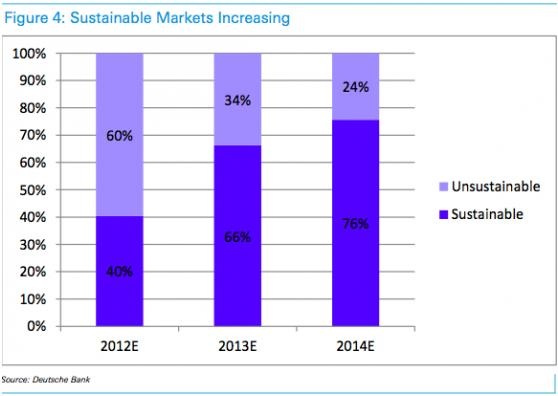Sharing the benefits of Asia's solar boom
This year’s second quarter saw a massive surge in solar panel shipments, with three of the four largest manufacturers outdoing projections by as much as 32 per cent, Bloomberg reports. Much of that was due to rising demand in Asia, where China and Japan could soon make up half the global demand for solar – with China in particular planning to double its solar capacity to about 10 gigawatts this year, and increase it by five times by 2015.
According to Stefan Linder, an analyst with Bloomberg New Energy Finance (BNEF), that swelling demand should soak up much of the oversupply solar manufacturers were recently struggling under. At the end of July, BNEF reported recovering solar stocks as well.
Solar’s prices may soon compete with those of traditional utilities without the aid of subsidies – something that Deutsche Bank’s latest market research calls a “third growth phase.” That doubles down on a similar finding the Germany-based financing and banking giant put out earlier this year. Thanks to balancing levels of supply and demand in both China and the rest of the global market, the cost of solar modules is stabilising at 60 to 70 cents per watt, while the cost of installation has reached $1 to $1.20 per watt.
Put it all together and solar’s levelised cost – the overall price at which it can deliver electricity generation when accounting for all its lifecycle inputs – is between 10 and 20 cents per kilowatt-hour for large portions of the globe.
According to Deutsche Bank, that leaves solar power hitting grid parity in eleven major markets worldwide – Los Angeles, Hawaii, Chile, Japan, South Korea, Australia, South Africa, Israel, Italy, Spain, and Greece – meaning its levelised cost can compete unsubsidised with traditional sources of electricity. The report also sees the potential for solar to cross that threshold in 10 to 20 other markets within the next three years. As soon as 2014, according to Deutsche Bank, three-quarters of the global solar market could be “sustainable” – ie. competitive without subsidies.

In particular, Deutsche Bank said rooftop, local ground-mounted, and other forms of small-scale distributed solar generation are going to drive much of the growth. That’s not just because of falling equipment and installation costs, but also because of new financing options.
In particular, solar power purchase agreements are allowing customers to avoid the hassles of overhead, installation, and permitting costs – one of the major barriers to distributed solar adoption. The individual customer acts as host for a third party firm that installs the solar on their property. The customer then gets the electricity at an agreed rate (usually below market value), while the firm handles installment, overhead costs, permitting, and the like.
Other financing models are also rising, as are solar power cooperatives – though the question of exactly how solar generation by individuals will integrate with utilities’ business models has to be hashed out before the market can really take off.
On the research and development end, Fraunhofer USA’s Center for Sustainable Energy Systems (CSE) is working on rooftop solar kits that can be assembled like an IKEA product and attached to a roof without drilling or infrastructure. A compact wireless system would then integrate with the local utility using a preset system.
In essence: a user-friendly plug-and-play solar system that should escape the need for rooftop inspection or permitting processes. CSE just received $11.7 million from the Department of Energy to try to develop the system within five years.
Now, critics of government subsidies might see Deutsche Bank’s conclusions as a case for eliminating solar’s subsidies, or that those subsidies should never have been in place to begin with. But because market prices don’t account for the economic and environmental cost of fossil fuel production, solar and other renewables are currently competing on an unfair playing field in which American fossil fuels are implicitly subsidised by half a trillion dollars per year.
Subsidies are an imperfect solution to that imbalance when compared with the benefits of a carbon tax. But they’re what’s politically feasible at the moment. And given how well solar is doing in the current environment, imagine its growth if the world was actually properly pricing its carbon emissions.
This article was originally published by Climate Progress. Republished with permission.













